Next week, on 23 September, Rosetta will depart on a three-week excursion that will take it up to 1500 km from the nucleus of Comet 67P/Churyumov-Gerasimenko, much farther than it has been since arriving at the comet in August 2014.
The main science goal driving this course of action is to study the coma of 67P/C-G on a broader scale while the comet’s activity is still high in the post-perihelion phase. While almost all instruments on Rosetta will be operating during the excursion, this exploration of the coma at large will be especially interesting to study the plasma environment of the comet with the Rosetta Plasma Consortium (RPC) instruments.
In particular, scientists are aiming at detecting the bow shock, a boundary between the comet’s magnetosphere and the ambient solar wind. The existence of a bow shock in a comet’s environment around its activity peak was predicted in 1967 by Ludwig Biermann, and confirmed in the past decades by observations at comets 21P/Giacobini–Zinner, 1P/Halley, 26P/Grigg–Skjellerup and 19P/Borrelly.
“Previous measurements that were performed during fly-bys only provided limited data points about the bow shocks of a handful of comets. Rosetta, instead, will take data over several days, monitoring the evolution of the plasma environment of 67P/C-G shortly after its perihelion,” says Claire Vallat, a Rosetta Science Ground Segment scientist at ESA’s European Space Astronomy Centre (ESAC).
Along the new trajectory, Rosetta will move away from the nucleus up to 1500 km in the direction of the Sun, where the bow shock is expected to be found. This maximum distance will be reached by the end of September, with the spacecraft returning to closer distances by mid-October.
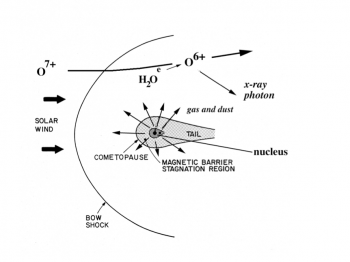
The plasma environment of an active comet. From T. E. Cravens & T. I. Gombosi, Cometary Magnetospheres: a tutorial, 2004, Advances in Space Research, Volume 33, Issue 11, p. 1968-1976.
“While it may appear odd to depart from the nucleus at this time, these measurements are also key to understanding the comet’s behaviour at large and must be performed not too long after perihelion, so that the comet is still appreciably active,” adds Claire.
Departure on the 1500-km excursion will be kicked off by an early morning thruster burn set for 01:40 GMT (03:40 CEST) on 23 September. The burn commands for a 2.34 m/s impulse push will be uploaded in advance and Rosetta will be pushed onto a slow escape path.
After the burn is complete, Rosetta will move out from its current orbit, approximately 450 km from the nucleus, aiming at the farthest point on the excursion with a phase angle of 50 deg, and arriving at 1500 km from the comet on 30 September. On that date, the spacecraft will be arriving on the morning side of 67P/C-G, over the comet’s southern hemisphere, at -60 degrees latitude.
“Once we’re far from the comet, we won’t be able to identify landmarks for navigation anymore as we’ll be too far out. Navigation will be based on the determination of the comet centre in NavCam images,” says Spacecraft Operations Manager Sylvain Lodiot at ESA’s European Space Operations Centre (ESOC).
Having reached the farthest point on this stretch, Rosetta will conduct a return burn, which will bring it back to about 500 km above the comet by 7 October. While the spacecraft is on the excursion, the cometary environment will continue to evolve, but the mission operations team won’t have a firm, up-to-date characterisation of the level of activity, so will make the return approach cautiously.
“We won’t stay at 500 km, but we’ll only get closer step by step, as we understand what’s then happening at the comet and regain knowledge of its activity,” says Lodiot.
As a comet gets closer to the Sun, frozen molecules – including water, carbon monoxide and carbon dioxide – both on and below the nucleus surface sublimate. As the outflowing gases leave the nucleus, they carry dust particles along and, together, they produce the comet’s coma.
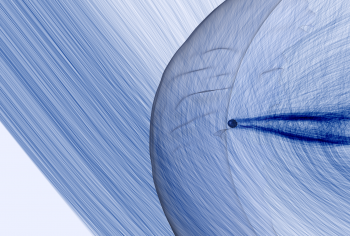
Visualisation of the magnetic field lines in the comet plasma environment. The “undisturbed” interplanetary magnetic field is visible on the left, the bow shock at the centre and the magnetic field draped around the comet on the right. The small blue sphere, with a radius of about 100 km, shows the size of the innermost coma, which contains the diamagnetic cavity, the ion and magnetic field pile-up regions. Credits: Modelling and simulation: Technische Universität Braunschweig and Deutsches Zentrum für Luft- und Raumfahrt; Visualisation: Zuse-Institut Berlin
The molecules in the coma are originally neutral, but can be stripped off of one or more of their electrons, thus becoming ionised, due to a variety of physical processes in the comet’s environment. The resulting molecular ions, such as H2O+ and O+, build up the comet’s magnetosphere and start interacting with the solar wind – a stream of charged particles and ions flowing from the Sun throughout the solar system.
The cometary ions, which move very slowly with respect to the high-speed flow of the solar wind, are “picked up” by the solar wind, adding more and more mass to its flow. As a consequence, the solar wind feels the presence of an obstacle, represented by the active comet, and decelerates gradually, until eventually a discontinuity arises with a sharp difference of the magnetic field values between the two plasma environments: the bow shock.
During fly-bys of previously visited comets, bow shocks were detected at distances of several thousands of km from the nucleus. In 1986, ESA’s Giotto mission measured a bow shock around one million km away from the nucleus of comet 1P/Halley; later, in 1992, it detected another bow shock during its fly-by of comet 26P/Grigg–Skjellerup, about 20,000 km from the nucleus.
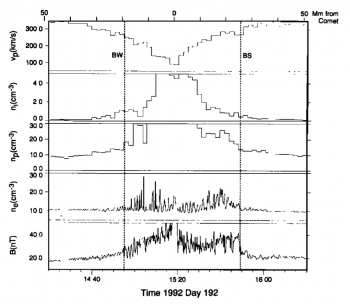
The plasma parameters measured by ESA’s Giotto mission in 1992, during its fly-by of Comet 26P/Grigg–Skjellerup. From A. J. Coates et al, 1997, Journal of Geophysical Research, vol. 102, no. A4, pages 7105.
“The location of the bow shock depends on the comet’s activity,” explains Hans Nilsson from the Swedish Institute for Space Physics, who is the Principal Investigator of the Ion Composition Analyser – one of the RPC instruments.
“Comet 1P/Halley was much more active than 67P/C-G, and the bow shock was much further away than what we expect to find with Rosetta. On the other hand, 26P/Grigg-Skjellerup was a relatively low-activity comet, and its gas production rate at the time of the Giotto encounter was similar to that of 67P/C-G at the time of perihelion.”
While Rosetta will not venture this far from the nucleus, the timing of the far excursion – six to eight weeks after perihelion – was planned in such a way that the bow shock will be closer to the nucleus.
“Hybrid plasma simulations indicate that a bow shock should have formed by now, and that we should see it around a thousand km from the nucleus,” explains Christoph Koenders, an RPC scientist from the Institute for Geophysics and Extraterrestrial Physics at the Technische Universität Braunschweig, Germany.
“The exact location of the boundary depends on the solar wind velocity and density, on the comet’s gas production rate and on the interplanetary magnetic field, and small variations in these parameters might shift it considerably. However, we are confident that we will detect the bow shock at some point during the excursion.”
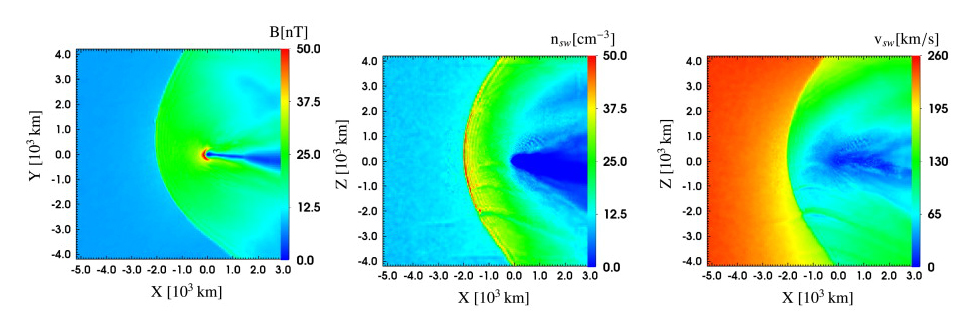
Visualisations from a hybrid plasma simulation of the interaction of Comet 67P/Churyumov–Gerasimenko at a distance of 1.3 Astronomical Units from the Sun, showing the strength of the magnetic field in the z=0 plane (left frame), the density (middle frame) and the velocity (right frame) of the solar wind protons. Adapted from C. Koenders et al, 2013, Planetary and Space Science, Vol. 87, Pages 85–95.
During the far excursion starting on 23 September, RPC scientists are planning to sample the magnetosphere of 67P/C-G at a range of distances from the nucleus that have not been probed yet, measuring the properties of ions and electrons and the magnetic field in the plasma environment. Besides the bow shock, they expect to detect several other transition regions, such as a cometopause and a cometary magnetosheath, as well as some other possible boundaries, which will all show a unique signature in each of the measurements.
While the temporal resolution of the data will be similar to that obtained during previous fly-bys of other comets, the spatial resolution will be improved by several orders of magnitude thanks to Rosetta’s much lower velocity with respect to the comet. In addition, there will be a chance to study temporal variations of the comet’s plasma environment, as the spacecraft will spend significant time in each region of the comet magnetosphere.
“Shocks are a ubiquitous phenomena in astrophysics and studying them in situ is a great way to get at the physics,” says Matt Taylor, Rosetta project scientist at ESA.
“For example, ESA’s Cluster mission explored the remarkably thin bow shock of our own planet a few years ago, revealing that it is an ideal site for particle acceleration. Now, Rosetta will allow us to study a bow shock of a very different celestial body in great detail. Since the conditions at this comet are just on the limit for the bow shock to form, we will have a chance to investigate in great detail how these boundaries arise.”
Scientists are looking forward to using these data to learn about the formation of shock waves and other boundaries in the plasma environment of a comet, and to examine how these affect the transfer of energy and momentum from the solar wind to the comet’s atmosphere. Comet 67P/C-G provides a new environment that allows to study the interaction of the solar wind in a context that is much different from that of a planet.

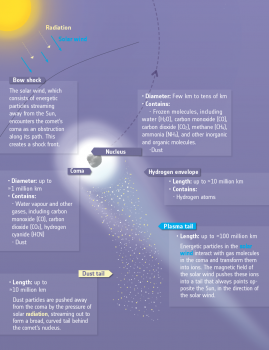








Discussion: 23 comments
Data is so beautiful!
https://blogs.esa.int/rosetta/files/2015/09/Plasma_Parameters_Giotto_Comet26P.png
Giotto, the little beast that could.
The document is well beyond my level, but seems to show Giotto injected itself below the magnetic terminator line an ejected above it.
“The panels show solar wind velocity, cometary ion density, proton density, electron density, and magnetic field strength. The bow wave (BW) and bow shock (BS) are marked on the plots.”
[Water] Ions in the single digit. Atomic particles well in the double. Integrations wouldn’t balance charges [for the path traveled].
A clearly ‘shocked’ bow, above magnetic terminator line.
Interesting how magnetic strength is arithmetic at tail side, and averagely constant at head side, in between BW and BS.
“On the basis of this comparison we assume here that the proton temperature was a constant 7 eV throughout”.
“…upstream electron temperature was assumed to be 13eV, half that at Halley, again consistent with this idea. The downstream temperature was assumed to be 18eV…”
No idea about meaning of upstream and downstream.
Protons increasingly decelerating at the Shock side. kind of constantly accelerating at the Wave side.
Ions, should be very complex dynamics about them.
Of note is that values are multi-pass deducted [Shape is also assumed]…
Very pleased this is being done.
The close in, photographic data etc is of course unique to Rosetta, but we really need this excursion to moderate distances to complete the picture.
It must inevitably lead to loss of the ‘close in’ data for a while. But we do have a lot of that, and should get more when Rosetta goes back close in. A price well worth paying.
I really look forward to the eventual results.
Hopefully pictures taken from afar will also give a new view of how the comet jets are turning back to form the tail.
Could imagine of big, orbit-ally quasi-bonded particulate as a nano ‘Oort Cloud’.
The document on the bow shock at 26P, from the AGU:
Bow shock analysis at comets Halley and Grigg-Skjellerup
Authors
A. J. Coates,
C. Mazelle,
F. M. Neubauer
First published: 1 April 1997
https://onlinelibrary.wiley.com/doi/10.1029/96JA04002/abstract
Is most of Ducky’s escaping atmosphere structurally vertical?
The solar wind plasma and the comet coma are two distinct plasmas with different properties. The boundary effects between plasmas of different properties are well understood in plasma physics. The principal effect on incoming positive ions at this boundary is likely to be an electric field effect, not a magnetic field effect. The field is more likely to accelerate the protons ( a great deal) than constitute any sort of barrier, though this depends on the relative charge state of the two plasmas. It is also likely that the radius of the coma is much greater than 1500 km. so the Rosetta craft is unlikely to reach that boundary.
The existence of the comet nucleus magnetic field has now been acknowledged by the ESA. It has however been noted that it is an extremely weak magnetic field, measured even a few tens of kilometres from the nucleus. Far weaker therefore at the coma boundary and unlikely to influence in any way the very high energy protons from the Sun, travelling this last week at in excess of 500 km per second (in the vicinity of Earth).
Unlikely then to provide a barrier to the protons anywhere within the coma; maybe a slight deflection close to the nucleus but no barrier and no “shock”.
A good way of determining how much of the proton flux crosses the plasma boundary or is deflected by the magnetic field would be to measure the proton density anywhere within the coma but particularly very close to the nucleus surface. We are told that it is the intention of this experimental fly away to take detailed ion measurements on course so even though it is unlikely to find any bow effect it should provide a detailed ion map along the radius of the coma out to 1500 km including the first good data on proton density along that path. Hopefully proton energy will be measured too. That would be revealing.
@Originaljohn
“The existence of the comet nucleus magnetic field has now been acknowledged by the ESA.”
Huh? The nucleus has no effect on the magnetic field per se. It is the solar wind, with its frozen-in magnetic field encountering the cometary species which produces the magnetic pile up regions at comets. As you may remember, the magnetic field, carried by the solar wind, dropped off totally (i.e. was shifted outward) after the large outburst around perihelion. It has nothing to do with the nucleus.
As for the rest of what you wrote, one assumes you are unaware of the previous missions which have investigated and observed these phenomena? For example at 19P Borrelly;
From https://iwww.tau.ac.il/~arkee/icarus_borelly.pdf;
“The solar wind speed reached a maximum of ~ 370 km/s and then began to slow noticeably at ~2.1 × 10^5 km from the nucleus…….Slowing and heating of the solar wind continued for the next hour until the cometary bow shock was encountered at ~1.52× 10^5 km from the nucleus……Total ion flow (i.e., all species included) in the cometosheath region clearly follows a pattern directed away from the comet as the nucleus–Sun line is approached………The near-nucleus perturbations to ion speed have a broader profile, with a minimum speed of 8 km/s roughly centered on closest approach. This resembles the cometopause region observed at Halley, which occurs when collisional processes such as charge transfer and Coulomb scattering become important factors in slowing the flow of mass loaded solar wind.” Et cetera.
Not to mention the discovery of the diamagnetic cavity at Halley, in which only cometary ions were detected. And the results from 26P Grigg-Skjellerup and 21P Giacobini-Zinner. And the fact that significant deflection of the solar wind has already been detected at this comet at less active times: https://www.aanda.org/articles/aa/pdf/forth/aa26046-15.pdf
For a broad overview of the subject, people may be interested in “Cometary magnetospheres: A tutorial” from: https://www.researchgate.net/profile/Thomas_Cravens/publication/222401364_Cometary_magnetospheres_a_tutorial/links/02bfe50db32d2579e4000000.pdf
One thing we do agree on; they are unlikely to find the bow shock within 1500km. At Grigg-Skjellerup, which was similar to 67P in its production rate, they found it at ~20 000km. However, other methods may be used to detect it:
https://www.aanda.org/articles/aa/pdf/2005/05/aagk241.pdf
Yep Ian the the magnetic field was confirmed by Dr Glassmeier in this blog when his published paper was discussed by Claudia on her post of the 19th August 2015 entitled ” what made the comet sing”. Claudia paraphrases it as
” even though the nucleus of 67P/C-G has no magnetic field of its own (as announced at this year’s EGU General Assembly), the comet’s atmosphere or coma is magnetised.” This magnetised coma is described as ” an induced cometary magnetosphere” A definition of a magnetosphere is ” the region of space surrounding an astronomical object in which charged particles are controlled by that object’s magnetic field.”
On the face of it this appears confusing, some might say contradictory but it is a complex issue and fully a matter of precise definition.
So as referred to above the EGU General Assembly announcement referenced the fact that the comet nucleus had been found to exhibit no intrinsic magnetism, which would be one way of displaying a magnetosphere. However the magnetosphere is referred to by Claudia as an “induced cometary magnetosphere” which is another way of displaying a magnetosphere, or a magnetic field. This is a complexity and the question is what induces the magnetic field.
Another complexity is that the comet nucleus is moving in the solar wind, which is the solar current flow, current flowing in the solar electric field. I suspect you would not accept this terminology but by definition it is correct. The solar wind is a flow of charged particles and that is the definition of an electric current.
I should say that I do not accept your terminology of a frozen in magnetic field. It is a commonly used term that is an impossibility, unless you would apply it to the field of say a permanent magnet. A plasma cannot have a frozen in magnetic field. It can however have an induced magnetic field or fields, induced by each individual olasma filament in which charged particles are moving. Should the charged particles stop moving the induced magnetic field would disappear. This field or these fields are manifested within the solar wind but they do not constitute the Sun’s magnetic field. That is a separate field centered on the Sun which is strongest close to the Sun and much weaker far from the Sun.
Now you also refer to the solar wind “encountering the cometary species which produces the magnetic pile up regions at comets” so you would agree that for the solar wind to encounter the cometary species and for them to interact they must be two different things. So the cometary species which includes the nucleus and coma, and its induced magnetic field, is separate from the solar wind. Its magnetic field is not a modification of the solar wind.
So what I consider induces the comets magnetic field is the current flowing from the nucleus as a result of its passage through the Sun’s electric field. It is an irrefutable fact that the only thing that can induce a magnetic field is the flow of an electric current.
So the complexity is that at the comet we are dealing with at least three separate magnetic fields, the Sun’s field, the solar wind filament fields and the comet’s field. Deploying a magnetometer in this region without further detailed knowledge the fields cannot be separated so the diamagnetic cavity is not a straightforward matter.
I would finish by saying that the only thing that can deflect an electric current flow is a magnetic field ( actually or another electric current flow) and the degree of deflection depends on the strength of the field. So the historical effects of comets on the solar wind were probably stronger comet magnetic fields than we are dealing with now. In any event why refer back to them for an understanding. They were fleeting flybys. We have a far better opportunity now to examine the effects in detail and achieve an understanding. I am very interested in the results of this Rosetta expedition within the coma and hope it will greatly enhance our understanding. My prediction remains that the solar wind ions will be little affected by the comets weak magnetosphere at 1500 km from the nucleus.
They will however be strongly influenced by the electric field boundary effect where the solar wind first encounters the plasma of the coma but as we agree that will be probably ten times further out than the Rosetta craft is going.
Which unobserved current flowing from the nucleus would this be? More evidence free nonsense, I suspect!
Well if evidence free makes it nonsense Ian there is your comet made of ice and ice sublimation hypotheses out the window.
The evidence is by inference for the current flow. We know the comet has no intrinsic magnetism yet it has a magnetic field. The only thing , apart from permanent magnetism, that can induce a magnetic field is an electric current. Thus by inference there is a flow of current associated with the comet.
Ah, so electrostatic deflection cathode ray tubes never worked then? Funny, because we all used them for years.
Just bending a wires works pretty well too 🙂
Though I’ll grant its not very relevant; but one should take care with phases like ‘the only thing….’
We must read quite different sets of ESA results. Those I saw made it quite clear the nucleus *does not* have a significant field, and that all the fields were consistent with those from the sun and the cometary plasma. The combined Philae descent/Rosetta measurements made that very clear.
The fields are indeed very weak; and the distances involved are very large; the latter compensates for the former. ‘Unlikely’ doesn’t come into it; we have detailed calculations.
Measurement to ‘very close to the comet surface’ are out of the question at the moment, far too dangerous for Rosetta
It’s interesting to read in the write-up that:
“Besides the bow shock, they expect to detect several other transition regions, such as a cometopause and a cometary magnetosheath, as well as *some other possible boundaries*, which will all show a unique signature in each of the measurements.”
Since we know that mainstream cosmology and hence the standard cometary model gives no credence to the notion of charge separation in space, it is no surprise that among the “boundaries” named here, there is no mention of the “double layer” (a.k.a. “plasma sheath”) which Nobel prize winner Hannes Alfven defined as being “a new class of celestial object”. This may well be one of the other (and perhaps even the main) “possible boundaries” which Rosetta will encounter. It is to be hoped, however, that the comet’s plasma sheath in the direction of the sun lies at a safe distance beyond the 1500 km limit of Rosetta’s exploration, for if Rosetta did happen to barge into this particular boundary at a time when the charge difference between the plasma of the coma and that of the “solar wind” on either side of the sheath is particularly high, then the result might a particularly nasty *electric* shock to the spacecraft and its precious electronically-operated instruments. It would be a shame to see Rosetta’s mission prematurely and unnecessarily curtailed by a simple oversight of this kind. Rosetta has a lot more useful observations to make and data to collect as 67P heads back out again towards aphelion.
@THOMAS
All of which fails to take into account the previous results from cometary missions! Why haven’t they encountered any of this? Main reason being it wasn’t there. How, for instance, did the spacecraft that encountered Halley, Giacobini-Zinner, Grigg-Skjellerup, Hartley 2 et al, manage to not only survive the encounter, but fail to notice this double layer and electric woo, whilst managing to make plenty of measurements to show that the “mainstream” idea is just fine, and needs no lessons from the evidence free zone that is EU “theory”.
No one would be terribly surprised if there was a double layer somewhere in the plasma structures around 67P, though I’m not aware of specific predictions of one. They are well known to occur, but would be on a scale typically of less than ten Debye lengths. On that scale charge separation can certainly occur. Shocks are entirel different, predicted – and clearly observed elsewhere.
Spacecraft are designed to cope with charging and EMC effects etc, and it’s very unlikely passing through one would threaten Rosetta in any way (maybe not utterly possible.) It bears no resemblance to ‘getting a shock’; these are very low density plasmas, and Rosetta is not standing in its bare feet on a conducting surface 🙂
The jets do not, ‘Bend’ but are illuminated by the Solar rays and will be in line from the Comet back towards the Sun.
Ref:- Kamals comment.
Clive: Thanks for the correction.
Tend to believe in a highly heterogeneous [composition, pressure, speed, vectors, temp, etc.] ‘escaping’ atmosphere. Now, the models should be ‘simplistic’ and, -at same time- catch general behavior. A really complex scenario for the scientists.
The comet is being heated a lot at this point. What is happening to Rosetta? How hot is it getting?
Hi Steve. She is far away, 1500km from the comet.
Steve. All spacecraft have to be designed with thermal control the in mind. Rosetta’s current distance from the sun, the only source of heat, is not dissimilar to the earth’s at the moment; so the problems are similar to earth orbit satellites.
A combination of methods is used. Controlling the surface ’emissivity’ – how well it radiates and absorbs heat, care over where heat is dissipated by electronics using heat pipes, sometimes passive louvre systems to change heat radiation. There is a whole field of spacecraft thermal engineering. So it will have been designed to keep its insides ‘comfortable’.